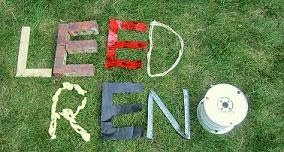Geothermal Energy
Geothermal (or Ground Source) heat pumps take advantage of the fact that after a certain depth the ground around our homes is a very consistent temperature. It is deep enough that it is insulated from the seasonal variations and ends up being a nice consistent temperature. So rather than go to the effort of creating heat in the winter and air conditioning in the summer, you just exchange heat with the soil. Ends up being a very efficient way to heat and cool a home.
Why we aren't doing it: Cost. To retrofit an existing home is in the tens of thousands of dollars. Geothermal will reduce your heating costs and end up paying for itself but ironically those savings are greatly reduced if you have a "green" home. The smaller and more energy efficient your home (i.e. the lower your heating bill) the longer it takes to save your money back. While a geothermal heat pump is out, we are planning on including an air-to-air thermal pump in our renovation.
Induction Stove
I have been trying to find an excuse to buy an induction stove for years. Traditional electric stoves heat a electric element which then heats the pot (or the glass cooktop and then the pot). Induction heating uses electromagnetic induction to heat the pot directly. The result is faster and more efficient heating. It also means you have electric heating that is a responsive as gas and a stove top that isn't hot and can't be left on (it doesn't work unless there is a pot there).
Why we aren't doing it: We have a good efficient stove that we can't justify replacing right now. Induction appliances are also pretty pricey.
Rainwater Capture
We will be buying rain barrels this spring. Collecting water in rain barrels for your garden and lawn have a host of benefits, but in the end it collects a very small fraction of the water. As an example, 25mm of rainfall results in 3750 L of water coming off our roof ( for the imperial readers 1" = 1000 gallons). Our rain barrels might collect 10% of that.
In the meantime the rest of the rain goes into the stormwater collection system, while at the same time we pump, filter, disinfect and fluoridate water from the river to our house and we just flush it down a toilet. Seems inefficient. Large scale rainwater capture or harvesting usually involves a large storage tank which provides water for the home and in some cases it can be completely self sustaining (i.e. no city water). I have also seen set ups where it is just a rain barrel in the attic that feeds the bathroom toilets.
Why we aren't doing it: The retrofit cost is high for a large scale unit and our home being a bungalow with a crazy roof line makes a small scale project awkward.
Greywater Recycling
Instead of collecting rainwater, why not collect and re-use your own waste water. Now to clarify, grey water includes everything that goes down the drain except toilet water.
Like rainwater, you can go big or small. Big projects include tanks and filtration systems but this could be as simple as the toilet/sink combo to the right. When you flush this Caroma designed toilet the tank refills via the above sink allowing you to wash your hands. That waste water is then stored for the next flush. I had seen a lot of these in the cramped bathrooms of Japan. Not only are they efficient they are also very compact.
Why we aren't doing it: Going big on this was too large a project and we couldn't figure out small projects that work for our home layout (and I already fell in love with a different toilet that I will blog about later.)
Green Wall
 A very cool development in green building is the increase in green or living walls. These are walls completely covered in vegetation that can be outside or inside your home. The attached picture was borrowed from a Canadian company called Green over Grey.
A very cool development in green building is the increase in green or living walls. These are walls completely covered in vegetation that can be outside or inside your home. The attached picture was borrowed from a Canadian company called Green over Grey.The benefits of a green wall? Aesthetics, built in air filtration, can control heat loss/gain, creates a relaxing natural environment.
Why we aren't doing it: Space. This is a feature to really design a home or building around, trickier with a retrofit unless you have a space that would naturally work well. Unfortunately we don't.
Green Roof
Similar to a green wall but obviously on top of your house. Green roofs have the same benefits of green walls but can also be used for things such as roof top gardening.
Why we aren't doing it: Pretty tricky to retrofit, especially on an sloped roof.





